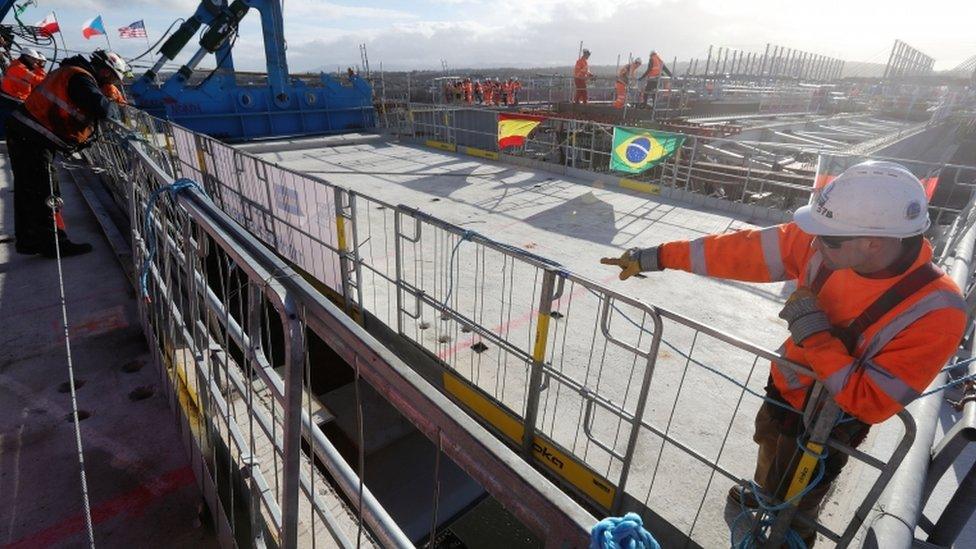Everything you need to know about the Queensferry Crossing
- Published
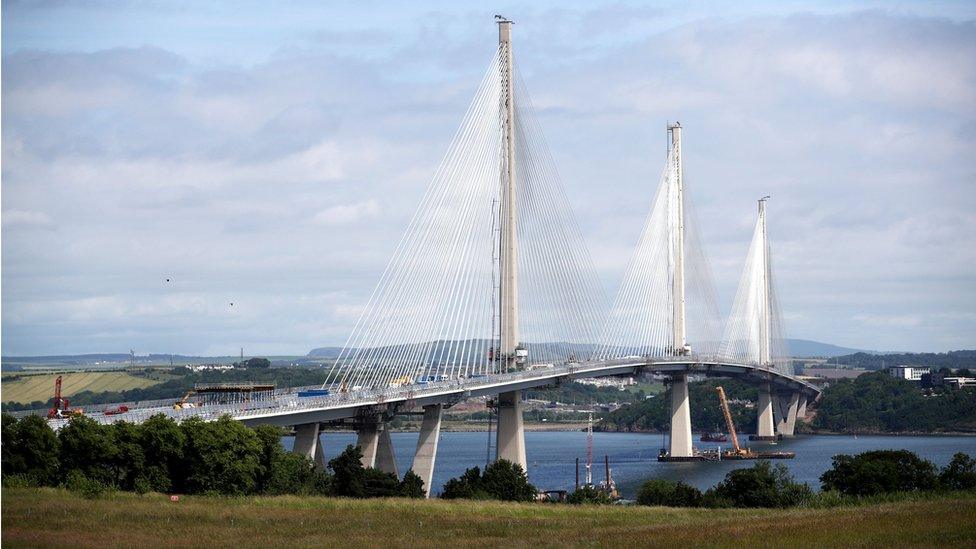
The new Queensferry Crossing will open on Wednesday 30 August
The Queensferry Crossing has opened to traffic for the first time, kicking off a week of events to celebrate the completion of the new £1.35bn bridge over the river Forth.
The man behind the building project, Michael Martin, said the new crossing was "one of the world's great bridges".
The new 1.7 miles (2.7km) publicly-funded crossing is the biggest infrastructure project in Scotland in a generation and will replace the Forth Road Bridge as the main road route between Edinburgh and Fife, carrying 24 million vehicles a year.
The existing road bridge, built in 1964 and dogged by maintenance problems, will continued to be used by cycles, pedestrians and eventually buses.
The iconic 19th Century Forth Bridge , which carries the railway over the river, lies just a mile away.

Opening the Queensferry Crossing - what next?
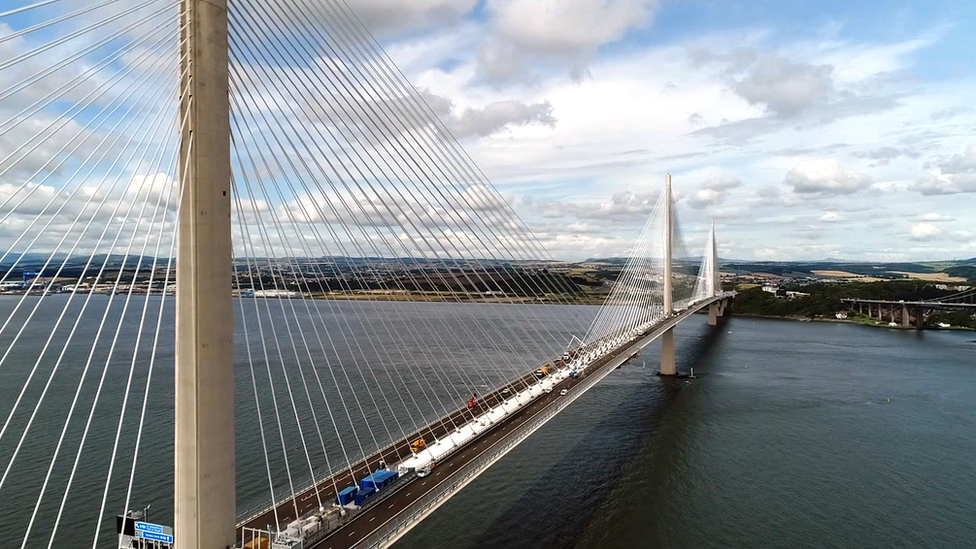
Saturday 2 & Sunday 3 September
About 50,000 members of the public, who were given tickets in a ballot, will get a "once in a lifetime" chance to walk over the new bridge on Saturday and Sunday.
Monday 4 September
The Queen will officially open the Queensferry Crossing.
The Moderator of the General Assembly of the Church of Scotland will bless the bridge, and the Queen will cut a ribbon on the south side.
Tuesday 5 September
A further 10,000 local people and school children will be given the opportunity to walk the bridge.
Thursday 7 September
The bridge will re-open to traffic, with no pedestrian access.
The initial speed limit will be 40mph but after work has been completed to adapt the Forth Road Bridge public transport will be switched back to the old bridge and the Queensferry Crossing will become a 70mph motorway.

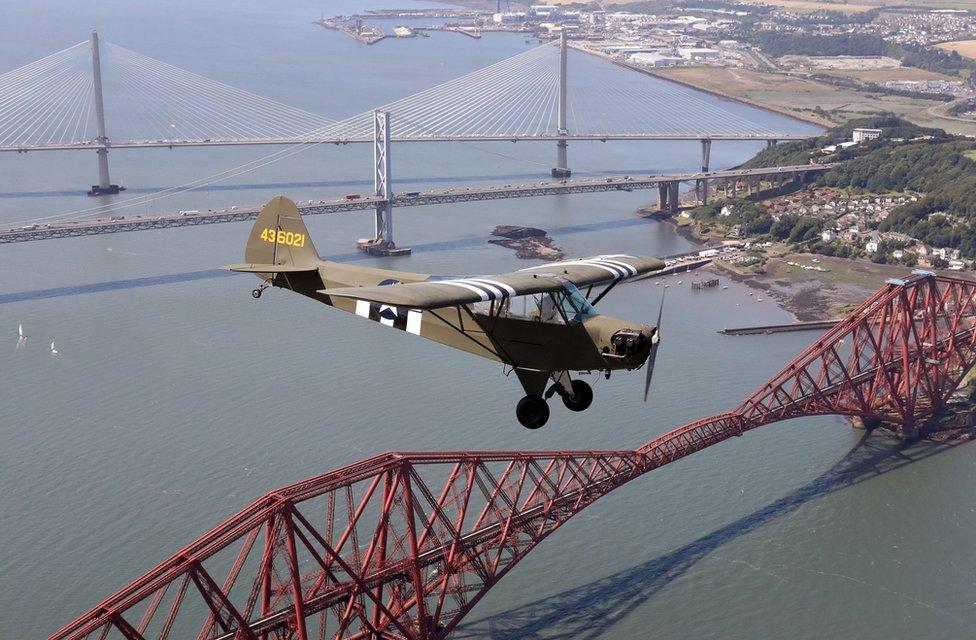
Jim McTaggart takes his 1940 Piper Cub over the Forth Rail Bridge, the Forth Road Bridge and the new Queensferry Crossing
The current Forth Road Bridge has been beset by problems since corrosion was found in its steel cables more than a decade ago.
The decision to replace it was taken in 2007, with construction of the new crossing beginning in September 2011.
Two years ago, the Forth Road Bridge was forced to close completely for three weeks while engineers repaired a serious defect in the metalwork, again underlining the need for the new bridge.
The Queensferry Crossing, the longest three-tower, cable-stayed bridge in the world, will take the vast bulk of the current load and unlike the existing bridge it is expected to remain open in all weathers.
Designers say 3.5m-high wind shields have been placed along each side of the bridge, which have been tested against the stormiest of conditions.
Transport Scotland project director David Climie told BBC Scotland: "We expect the wind shields to almost entirely eliminate the need for closures during the frequent periods of high winds in the Forth estuary, apart from in exceptional circumstances.
"This will increase the resilience of what will be the main crossing over the Forth estuary in future."
Engineers proud of 'state-of-the-art' bridge
Mike Glover, who has managed the bridge project for the decade since it was first approved, told the BBC the crossing would last at least 120 years because its design would make it easy to maintain.
The civil engineer said there were two main reasons for predicting such longevity.
"The first is that the exterior of the bridge is a continuous structure - it is a box - which means the level of maintenance that is required is very minimal, unlike the trusses on the current suspension bridge," Mr Glover said.
"The second is because the individual cables that make up the cable-stay bridge each one can be replaced without the stability of the bridge being in doubt.
"Whereas with the suspension bridge any problem with that suspension cable means that the bridge would have to be closed."

The deck of the new bridge will have two lanes in each direction as well as hard shoulders to ensure that breakdowns do not cause congestion.
Designers claim this will also allow buses to be moved from the Forth Road Bridge in high winds or other dangerous weather conditions.
As the new bridge will be a designated motorway, it means learner drivers and motorbikes under 50cc will not be allowed on it.
Mr Glover told the BBC that travelling across the new bridge would be much smoother than the current one, because it only has two joints on the whole deck.
"That means the whole road surface is continuous, no bumps, no disruption, just silence," he says.
"The existing road bridge is made up of sections which are 60ft long and therefore you have in excess of 100 individual joins, which causes the bumps as you go across it.
"Not only is it uncomfortable for motorists but actually it causes a lot of fatigue damage in the bridge itself."

Cost and construction
The new £1.35bn Queensferry Crossing comes to life in multi-colour.
In the early stages of planning the bridge it was suggested it would cost £2bn but by the time the Forth Crossing Bridge Constructors (FCBC) group began building in 2011 the price range was £1.45bn to £1.6bn.
Two years later the Scottish government announced the range had been lowered to £1.4bn - £1.45bn.
John Swinney, the finance secretary at the time, said the lower cost was a result of "successful management" and the "delivery of key milestones".
Mr Swinney also announced the new bridge, which has been completely publicly funded, would be toll-free like all other road bridges in Scotland.
The projected cost of the new bridge was reduced again in October 2014 when the upper limit was lowered by £50m to £1.4bn.
Nicola Sturgeon, who was then deputy first minister, said the project would be completed by the end of 2016.
The final cost of the bridge is said to be £1.35bn, well within budget, but the opening date has slipped by nine months, mainly due to the weather.
The bridge's technical director Mike Glover said the weather in the Firth of Forth had been "particularly unkind", especially at the point when they were 200m in the air attaching cables.

Queensferry Crossing - facts and figures
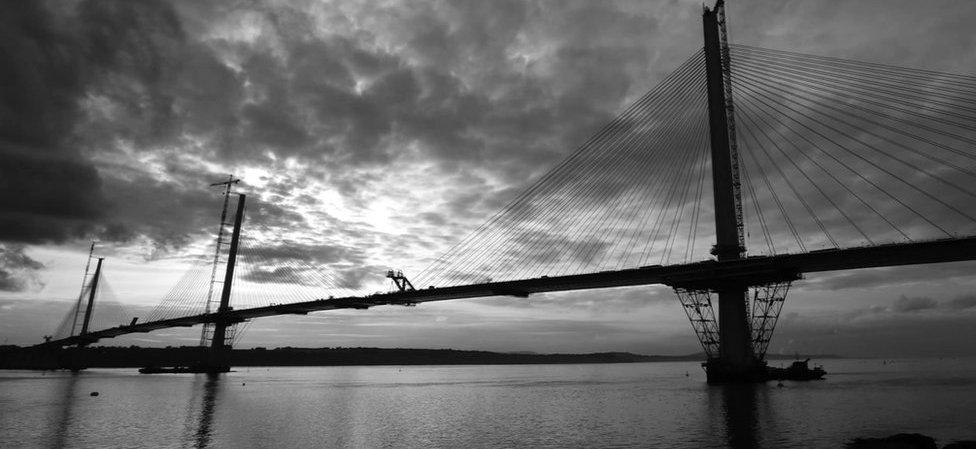
More than 15,000 people have been involved in the project since the inception of plans for a new bridge in 2007.
The structure is 207m above high tide (683ft), equivalent to about 48 double decker buses stacked on top of each other.
It is 50m (25%) higher than the existing Forth Road Bridge
The steel required for the bridge deck weighs a total of 35,000 tonnes - equivalent to almost 200 Boeing 747s
The combined steel required for North and South viaducts weighs 7,000 tonnes - enough to make another 23 Kelpies.
The bridge has windshielding to almost entirely eliminate the need for closures during the frequent periods of high winds in the Forth estuary
Cables can be replaced with more ease than on the Forth Road Bridge - it can be done as part of normal maintenance works without closing the bridge.
The foundations of the bridge are large caisson - circular steel structures - sunk into the mud of the estuary to bedrock level.
The south caisson is the height of the Statue of Liberty. It is 35m in diameter and when it was constructed it was 50m in height.
At the southern tower they poured 16,000 cubic metres of concrete over a period of 15 days continuously from barges on the river.

Walking across the bridge
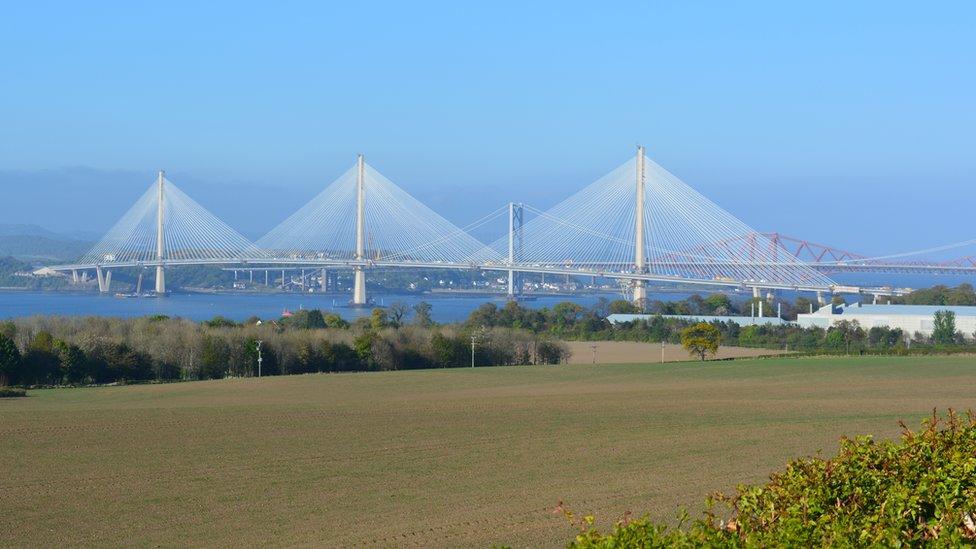
Members of the public will get the chance to walk across the bridge before its official opening
Once it is fully operational there will be no pedestrian access to the bridge, instead people will be able to walk across the existing Forth Road Bridge.
However, an online ballot was held to select 50,000 people to walk across the new crossing on the weekend of Saturday 2 and Sunday 3 September.
The "once-in-a-lifetime" opportunity attracted applications from more than 226,000 people, mainly from Scotland.
About 5,180 people entered have postcodes from elsewhere in the UK and the remaining 437 are from the rest of the world, including the United States, India and one single entrant from Slovakia.
In addition to this, a further 10,000 people from local schools and community groups on both sides of the Forth will be able to walk on the bridge on Tuesday 5 September, the day after its official opening by the Queen.

Queen to open the bridge
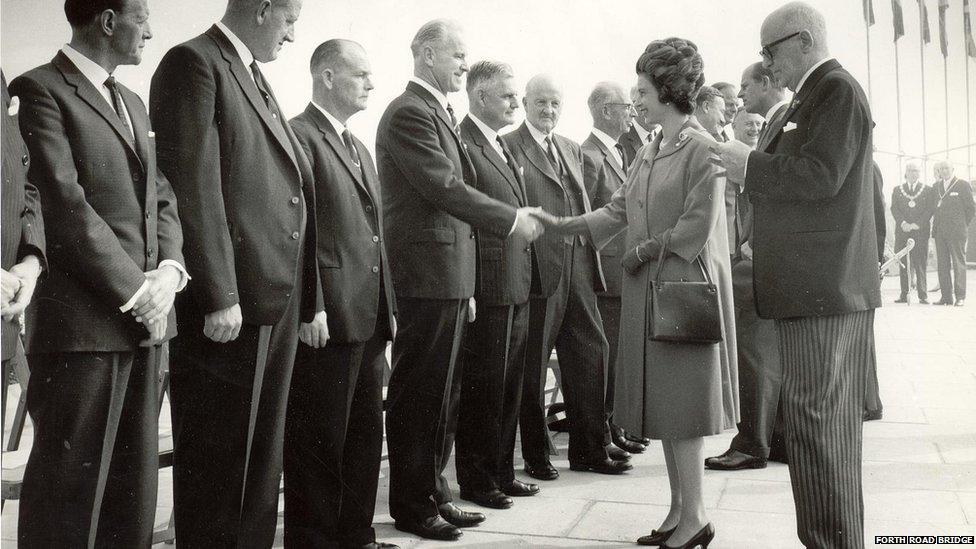
The Queen formally opened the Forth Road Bridge in 1964
The Queen will open the bridge on Monday 4 September, exactly 53 years after she opened the Forth Road Bridge.
It has also been announced that she will be accompanied by the Duke of Edinburgh, in his first official appearance alongside the Queen since retiring from solo engagements.
Other events on the day will include a welcome address by First Minister Nicola Sturgeon and a blessing by the moderator of the General Assembly of the Church of Scotland.
Scotland's Makar, Jackie Kay, will read a poem specially commissioned for the occasion and there will be live music performances.
- Published4 August 2017

- Published2 December 2015

- Published11 February 2020
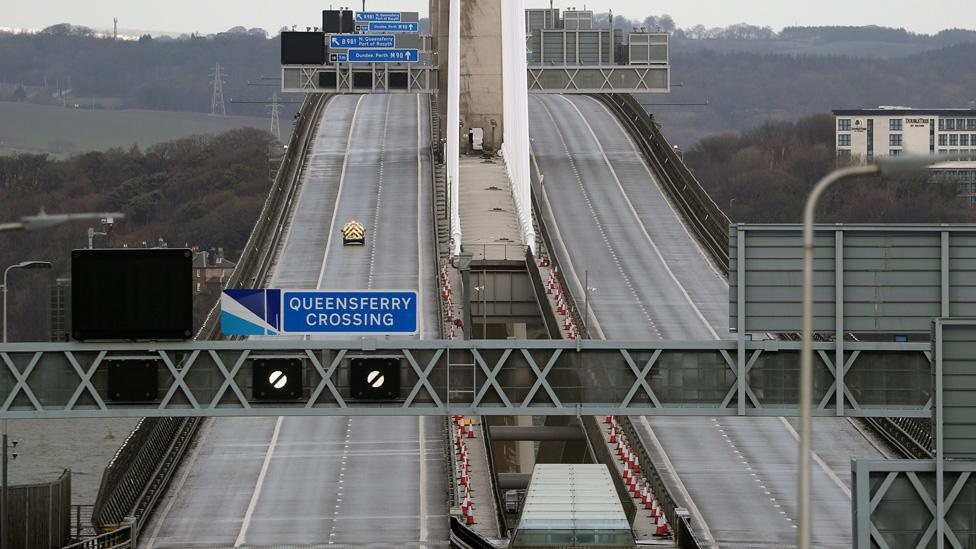
- Published3 February 2017
